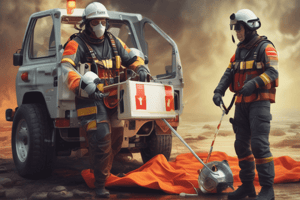Podcast
Questions and Answers
What is the primary responsibility of the Extrication Sector?
What is the primary responsibility of the Extrication Sector?
- Supervise the Treatment Sector
- Determine location, number, and condition of all patients (correct)
- Coordinate with the Triage Sector to prioritize patients
- Provide medical treatment to patients
Who is responsible for requesting assistance for patient needs?
Who is responsible for requesting assistance for patient needs?
- The Extrication Sector Officer
- The Company Officer (correct)
- The Triage Officer
- The Treatment Sector Officer
Where should the treatment area be located in relation to the incident scene?
Where should the treatment area be located in relation to the incident scene?
- In a location that is hidden from view to minimize distraction
- In a location that is central to the incident scene and accessible by all responders
- In a location that is close to the incident scene but away from dangerous conditions (correct)
- In a location that is easily accessible but far from the incident scene
What is the purpose of designating separate 'IMMEDIATE' and 'DELAYED' treatment areas?
What is the purpose of designating separate 'IMMEDIATE' and 'DELAYED' treatment areas?
Who is responsible for advising Command when ready to receive patients?
Who is responsible for advising Command when ready to receive patients?
Where should the first arriving patients be placed in the treatment area?
Where should the first arriving patients be placed in the treatment area?
What is the primary role of ALS personnel in the Treatment Sector?
What is the primary role of ALS personnel in the Treatment Sector?
How should patients be arranged in the treatment area?
How should patients be arranged in the treatment area?
Who has full supervisory authority over non-fire department medical personnel?
Who has full supervisory authority over non-fire department medical personnel?
What should the Treatment Sector officer prioritize when it comes to treatment and packaging of patients?
What should the Treatment Sector officer prioritize when it comes to treatment and packaging of patients?
Who is responsible for determining the need for additional medical supplies at the scene?
Who is responsible for determining the need for additional medical supplies at the scene?
What should the Treatment Sector officer do when all IMMEDIATE patients have been treated?
What should the Treatment Sector officer do when all IMMEDIATE patients have been treated?
What is the primary objective of the Treatment Sector?
What is the primary objective of the Treatment Sector?
What is the first step in establishing a Treatment Sector?
What is the first step in establishing a Treatment Sector?
What is the responsibility of the Treatment Sector regarding patient triage?
What is the responsibility of the Treatment Sector regarding patient triage?
How does the Treatment Sector officer direct companies to specific patients?
How does the Treatment Sector officer direct companies to specific patients?
What is the role of the Sector officer in the Treatment Sector?
What is the role of the Sector officer in the Treatment Sector?
What is the responsibility of the Treatment Sector regarding patient safety?
What is the responsibility of the Treatment Sector regarding patient safety?
Flashcards are hidden until you start studying
Study Notes
Extrication Sector Responsibilities
- Determine location, number, and condition of all patients, coordinating with Triage
- Decide on triage location: in place or at the treatment area entrance
- Determine resources and assign/supervise extrication teams
- Extricate and deliver patients to treatment areas or casualty collection points
- Provide frequent progress reports to Command
- Ensure patient and personnel safety and accountability
- Coordinate with other sectors
- Notify Command when all patients are removed and companies are available for reassignment
Extrication Sector Officer Guidelines
- Wear a sector vest for identification
- Position in a visible, accessible location with a view of the scene
- Maintain face-to-face communication within the sector
- Use messengers to relay information to the sector officer
- Provide frequent progress reports to Command
Patient Removal Priorities
- IMMEDIATE patients removed to treatment areas without delay
- DELAYED patients removed after IMMEDIATE patients, unless access is restricted
- Non-ambulatory patients moved on backboards with cervical spine precautions if necessary
Resource Allocation
- Initial commitment: one company per five victims
- Assign companies to specific areas or groups of patients
- Company officers responsible for patient needs and requesting assistance
- Divide responsibility geographically in large incidents, with designated sector names (e.g., "North Extrication")
ALS Personnel and Specialized Equipment
- Most ALS personnel assigned to the Treatment Sector
- Some paramedics may be assigned to the Extrication Sector for critical patients
- Ladder companies assigned for forcible extrication
- Request specialized equipment (wreckers, cranes, cutting torches) through Command
Safety and Congestion Control
- Ensure safety of the extrication area
- Commit personnel with protective lines and extinguishing equipment where a fire risk exists
- Reduce confusion and congestion by directing MINOR patients to a specific area
- Extrication Sector responsible for further assessing and transporting MINOR patients to an "Assembly Area"
Treatment Sector Overview
- A Treatment Sector is established to manage the treatment of multiple IMMEDIATE and DELAYED patients.
- The Treatment Sector is responsible for setting up a treatment area to provide stabilization and continuing care of patients until they can be transported to a medical facility.
Treatment Sector Responsibilities
- Identify whether patient treatment will occur “in place” or in a designated treatment area.
- Determine resources and assign treatment teams.
- Ensure all patients have been triaged, assessed, and re-triaged as needed.
- Provide aggressive treatment and rapid packaging of patients.
- Provide frequent progress reports to Command.
- Ensure safety and accountability of all patients and assigned personnel.
- Verify transportation priorities with Transportation Sector.
- Coordinate with other sectors.
Establishing a Treatment Area
- The Treatment Sector officer establishes a large treatment area, separate from the incident scene.
- If the incident is large, separate "IMMEDIATE" and "DELAYED" treatment areas are established.
- The treatment area must be readily accessible for patient entry and transportation loading, away from dangerous conditions.
- The area should be large enough to absorb all patients and treatment personnel.
Treatment Area Operations
- Patients are arranged in an orderly manner, with adequate space provided between patients for treatment personnel.
- First arriving patients are placed near the exit point, and rescuers fill from exit towards the entrance as patients are delivered.
- Non-triaged patients arriving at the treatment area are triaged and tagged at the entrance.
- ALS treatment is given primarily in the "IMMEDIATE" treatment area, with less intensive patient monitoring and treatment in the "DELAYED" treatment area.
- Medical information is documented on the triage tag.
Treatment Sector Officer Responsibilities
- The Treatment Sector officer assigns personnel to meet and direct first arriving litter-bearers.
- The officer advises Command when ready to receive patients.
- The officer ensures treatment is rapid, adequate, and appropriate numbers of treatment personnel are assigned to each patient.
- The officer maintains awareness of which patients are ready for transport.
- The officer ensures close coordination with the Transportation Sector officer for rapid transportation.
Studying That Suits You
Use AI to generate personalized quizzes and flashcards to suit your learning preferences.




